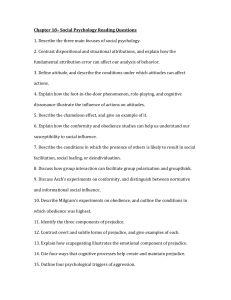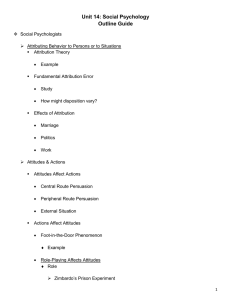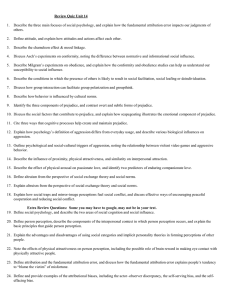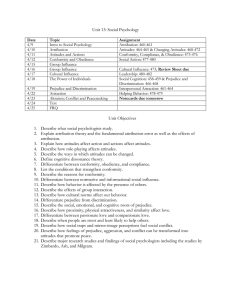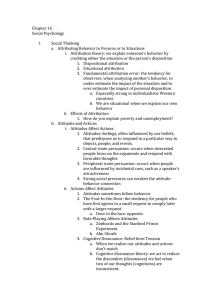Chapter 18 Social Psychology
advertisement
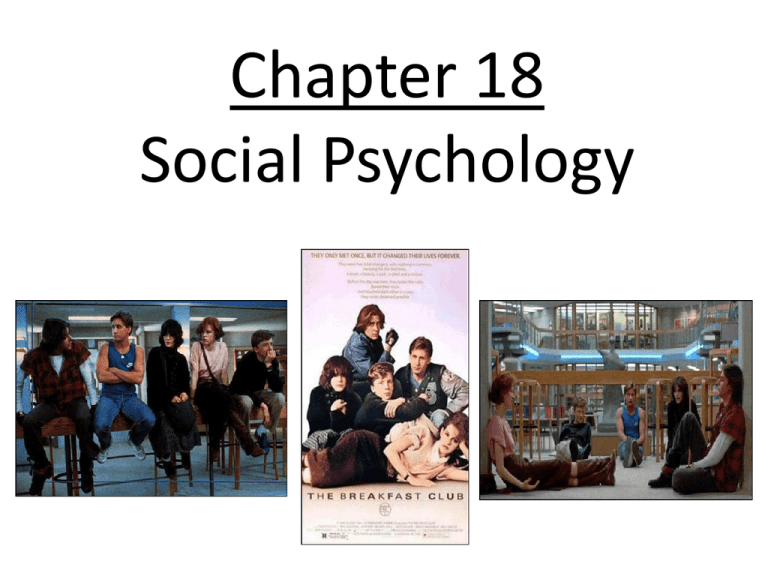
Chapter 18 Social Psychology Social Psychology “We cannot live for ourselves alone.” Herman Melville Social psychology scientifically studies how we think about, influence, and relate to one another. Attributing Behavior to Persons or to Situations Attribution Theory Heider suggested that we have a tendency to give causal explanations for someone’s behavior, often by crediting either the situation or the person’s disposition. Fritz Heider Attribution Theory A teacher may wonder whether a child’s hostility reflects an aggressive personality (dispositional attribution) or is a reaction to a stressful or abusive environment (situational attribution). Dispositions are enduring personality traits. So, if Joe is a quiet, shy, and introverted child, he is likely to be like that in a number of situations. Fundamental Attribution Error The tendency to overestimate the impact of personal disposition and underestimate the impact of the situations in analyzing the behaviors of others leads to the fundamental attribution error. We tend to commit the fundamental attribution error when judging others. We tend to understand the power of the situation better when we see our behaviors. Effects of Attribution How we explain someone’s behavior affects how we react to it. Attitude A belief and feeling that predisposes a person to respond in a particular way to objects, other people, and events. If we believe a person is mean, we may feel dislike for the person and act in an unfriendly manner. Foot-in-the-Door Phenomenon In the Korean War, Chinese communists solicited cooperation from US army prisoners by asking them to carry out small errands. By complying to small errands they were likely to comply to larger ones. Foot-in-the-Door Phenomenon: The tendency for people who have first agreed to a small request to comply later with a larger request. Role Playing Affects Attitude: Zimbardo’s Stanford Prison Experiment • The work of Philip Zimbardo • Wanted to learn about behaviors and feelings of prisoners or guards • Set up a phony prison in a university building • Recruited male college students to participate • Randomly assigned 24 participants to role of either prisoner or guard http://www.prisonexp.org/ Philip “Uncle Phil” Zimbardo Stanford Prison Experiment: Methodology • Guards instructed to make prisoners feel frustrated and not in control • Prisoners arrested and booked as real prisoners • Guards bullied the prisoners, began cruel treatment of prisoners and even developed feelings of power. Stanford Prison Experiment: Results • Prisoners staged a rebellion on the second day • Guards stepped up their harassment and treated rebellion “ringleaders” differently than the “good” prisoners • Prisoners told they couldn’t leave; many became anxious • Guards increased bullying tactics as they perceived prisoners to be a real threat • Everyone took on the role to which they were assigned—the experiment became very realistic (self-fulfilling prophecy) • Experiment ended after six days instead of two weeks • Prisoners had lost their identity http://www.youtube.com/watch?v=Z0jYx8nwjFQ Actions Can Affect Attitudes Why do actions affect attitudes? Leon Festinger’s explanation is that when our attitudes and actions are opposed, we experience tension. This is called cognitive dissonance. To relieve ourselves of this tension we bring our attitudes closer to our actions. People want to have consistent attitudes and behaviors….when they are not consistent they experience dissonance (an unpleasant tension). Usually they will change their attitude (to make themselves feel better). Part II: Social Influence The greatest contribution of social psychology is its study of attitudes, beliefs, decisions, and actions and the way they are molded by social influence. Why do people conform? Normative Social Influence: Influence resulting from a person’s desire to gain approval or avoid rejection. A person may follow social norms because there may be a severe price to pay if not followed. Informative Social Influence: The group may provide valuable information or help you make tough decisions (after all we like to be right); however, stubborn people will never listen to others. Conformity & Obedience Behavior is contagious, modeled by one, followed by another. We follow behavior of others to conform. Other behaviors may be an expression of compliance (obedience) toward authority. Conformity Obedience Conformity: Adjusting one’s behavior or thinking to coincide with a group standard. Solomon Asch’s Conformity Experiment • Group Pressure and Conformity experiment • Subject asked to match one of three lines to a “standard line”; the answer was obvious http://www.betterd aystv.net/play.php ?vid=19441 Solomon Asch Standard Line Comparison Lines Asch: Methodology & Results Standard Line Comparison Lines • Other group members insisted that one of the shorter lines was actually the same height as the standard line • Subject began to question what he had thought was the obvious answer • Subject is relatively likely to give the same answer as the group, even if it’s obviously incorrect • Less than 1% of subjects chose the wrong line when asked the question on their own • More than one-third of subjects chose the wrong line when asked in a group that had chosen the same wrong line Conditions that Strengthen Conformity 1. 2. 3. 4. 5. 6. 7. One is made to feel incompetent or insecure. The group has at least three people. The group is unanimous. One admires the group’s status and attractiveness. One has no prior commitment or response. The group observes one’s behavior. One’s culture strongly encourages respect for a social standard. Obedience People comply to social pressures. How would they respond to outright command? Stanley Milgram designed a study that investigates the effects of authority on obedience. Stanley Milgram (1933-1984) Stanley Milgram’s Obedience Experiment • Real subjects were assigned the role of teacher • Actors assigned the role of learner, but the actual subjects thought the learners were also subjects in the experiment • Teacher instructed to give the learner electric shocks if he answered a question wrong • Teacher didn’t know the shocks were not real Milgram: Methodology & Results • Learner would groan and eventually scream in agony • The experimenter insisted that the teacher continue • Teachers were visibly distressed about the experiment, but 63% continued it until the end • When the learner said he had a “slight heart condition” and screamed even louder, 65% of teachers continued until the end • Similar results for women and for men Milgram: Further Findings • • Teachers most likely to obey perceived authority figures, especially those from prestigious institutions More likely to obey instructions when “victim” was at a distance and depersonalized • More likely to obey without role models who defied the authority figure’s orders http://today.msnbc.msn.com/id/26184891/vp/34878372#35946104 Individual Resistance A third of the individuals in Milgram’s study resisted social coercion. An unarmed individual single-handedly challenged a line of tanks at Tiananmen Square. Implications of Milgram’s Experiments • Obedience to authority can keep people from following their own morals and standards • Ordinary people can perform cruelties in the process of obeying authority figures in their daily lives • Incrementally increasing the level of shock made it more acceptable for the teachers to continue but were still torn in hearing the victim’s screams. Group Influence How do groups affect our behavior? Social psychologists study various groups: 1. 2. 3. 4. One person affecting another Families Teams Committees Social Facilitation Refers to improved performance on tasks in the presence of others. Triplett noticed cyclists’ race times were faster when they competed against others than when they just raced against the clock. Opposite is social impairment. You play the piano better at your recital than you do during weekly practices. Social Loafing The tendency of an individual in a group to exert less effort toward attaining a common goal than when tested individually. Why does it happen? 1. We pull harder by ourselves! People tend to feel less accountable in a group setting 2. People tend to rely on the efforts of their group mates more. “Slackers” in a group project. They tend to put forth more effort if they know there is an individual/peer evaluation. Deindividuation The loss of self-awareness and self-restraint in group situations that foster arousal and anonymity. We engage in uncharacteristic antisocial behavior. Prosocial behavior can result as well. Looting v. Volunteering during Hurricane Katrina Group Polarization Enhances a group’s prevailing attitudes through a discussion. If a group is likeminded, discussion strengthens its prevailing opinions and attitudes. Groupthink Irving Janus came up with this principle in which a mode of thinking that occurs when the desire for harmony in a decision-making group overrides the realistic appraisal of alternatives. Attack on Pearl Harbor Bay of Pigs & Cuban Missile Crisis Watergate Cover-up Chernobyl Reactor Accident Prejudice Simply called “prejudgment,” a prejudice is an unjustifiable (usually negative) attitude toward a group and its members. Based on a stereotype, prejudice is often directed towards different cultural, ethnic, or gender groups. Components of Prejudice 1. Beliefs (stereotypes) 2. Emotions (hostility, envy, fear) 3. Predisposition to act (to discriminate) Stereotype: • Overgeneralized idea about a group of people (representative heuristic). Prejudice: • Undeserved (usually negative) attitude towards a group of people. Ethnocentrism is an example of a prejudice. Discrimination: • An action based on a prejudice. Does perception change with race? Reign of Prejudice Prejudice works at the conscious and [more at] the unconscious level. Therefore, prejudice is more like a knee-jerk response than a conscious decision. In the last few decades, overt prejudice has decreased, yet subtle prejudices still exists. Why does prejudice arise? 1. Social Inequalities (increases prejudice) 2. Social Divisions 3. Emotional Scapegoating http://wimp.com/stealingbike/ In & Out Groups In group: Those with whom one shares a common identity. Out group: Those perceived as different from one’s in group. In group Bias: The tendency to favor one’s own group. When our team wins we say “we won” & when they lose we say “they lost.” Emotional Roots of Prejudice Prejudice provides an outlet for anger [emotion] by providing someone to blame. After 9/11 many people lashed out against innocent Arab-Americans. This is one example of Scapegoat Theory. People love to blame somebody else (usually based on prejudices)! Just-World Phenomenon The tendency of people to believe the world is just, and people get what they deserve and deserve what they get. Is often the reason that we sometimes blame the victim (for instance, she was raped because she dresses provocatively). Hindsight Bias After learning an outcome, the tendency to believe that we could have predicted it beforehand may contribute to blaming the victim and forming a prejudice against them. “I knew that Asian kid would be valedictorian!” Conflict Conflict is perceived as an incompatibility of actions, goals, or ideas. A Social Trap is a situation in which the conflicting parties, by each rationally pursuing their self-interest, become caught in mutually destructive behavior. “The water that I am personally using is not that much anyway.” (If everybody thought that way we would run out more quickly!) Psychology of Attraction 1. Proximity: Geographic nearness is a powerful predictor of friendship. Robert Zajonc and others discovered that repeated exposure to novel stimuli increases their attraction (mere exposure effect). 2. Physical Attractiveness: Once proximity affords contact, the next most important thing in attraction is physical appearance. Many studies have shown that more attractive people are more popular, are treated better, earn more money and are perceived to be happier than less attractive people. 3. Similarity: Similar views among individuals causes the bond of attraction to strengthen. Similarity breeds content and opposites usually do not attract! Romantic Love Passionate Love: An aroused state of intense positive absorption in another, usually present at the beginning of a love relationship. Companionate Love: A deep, affectionate attachment we feel for those with whom our lives are intertwined. 1. Equity – both partners share equally in the relationship 2. Self-disclosure – honest sharing of details about ourselves. Prosocial Behaviors Altruism is an unselfish regard for the welfare of others. • March 13, 1964 – Kitty Genovese was brutally attacked outside her apartment in Queens, NYC. She was stabbed and raped. • In spite of her repeated screams for help, why didn’t Kitty Genovese’s neighbors call the police earlier or help her in some other way before it was too late? John Darley and Bibb Latané’s Bystander Intervention Experiment •The Genovese case as well as other similar cases caused Darley and Latane to study why people didn’t help out. In their experiment they hypothesized that people would be less likely to report smoke in a room if others were present •Placed subjects in rooms that filled with smoke •75% of subjects reported smoke if they were alone Darley and Latané: Results In order for bystanders to help: • People have to notice the incident • People have to interpret the incident as urgent • People have to take responsibility for helping out Darley and Latané: Further Studies • There are certain circumstances under which people are more likely to help someone in need when: – – – – – – – – they’re not in a hurry they have observed someone else being helpful they feel guilty they’re in a good mood they’re focused on others and not preoccupied they’re outside of an urban area the victim appears to be truly deserving of help the victim is similar in appearance or other characteristics to the bystanders But… People are less likely to help if others are around. This is called the Bystander Effect (diffusion of responsibility) The Norms for Helping Social Exchange Theory: Our social behavior is an exchange process. The aim is to maximize benefits and minimize costs. You’ll help if the rewards for doing so outweigh the costs of helping. Reciprocity Norm: The expectation that we should return help and not harm those who have helped us. Social–Responsibility Norm: Largely learned, it is a norm that tells us to help others when they need us even though they may not repay us. This is how frequent volunteers often feel. Muzafer Sherif’s “Robber’s Cave” Experiment • 22 Boy Scouts divided into two equal groups • Stage 1: each group lived separately, developed their own rules and leadership • At end of stage 1, began to become aware of the other group • In stage 2, intense rivalry developed between the two groups • Researchers kept the scores close & had them compete for prizes “Robber’s Cave” Experiment • Researchers tried to build peace between the two groups • Best way: developing Superordinate Goals (shared goals that override differences among people and require their cooperation). • Peace building worked well; boys ended up getting along
